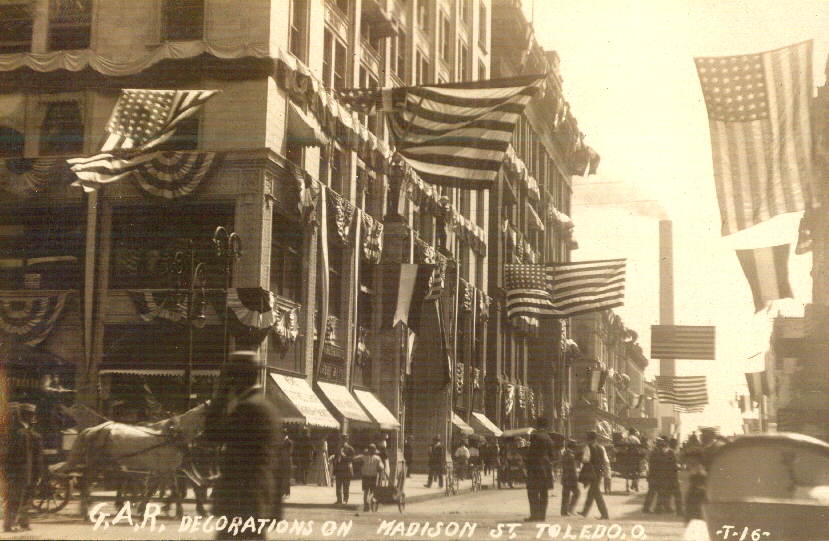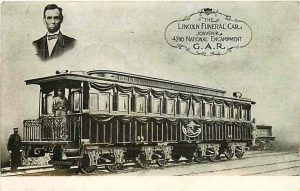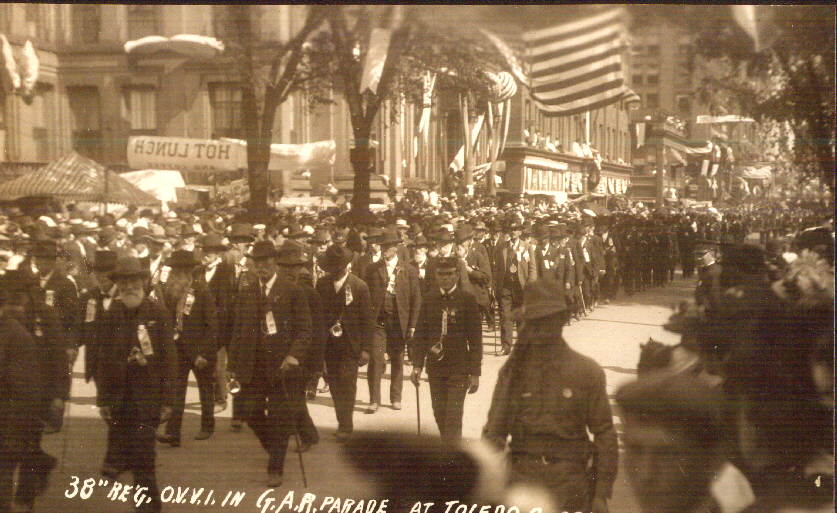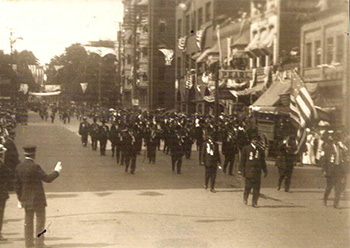Toledo had never seen anything like the September 1908 G.A.R. Encampment, and it may never again.
The G.A.R. – Grand Army of the Republic – was a veteran’s and fraternal organization organized after the Civil War by the winners of said war, the Union. It reached its peak in 1890 when it had 400,000 members and over 7,000 posts. Toledo was the site of its forty-second National Encampment (it was not a campout by any means but a national convention, generally held in major American cities).
By 1908, even the youngest of Civil War enlistees were in their sixties, so it was an organization whose influence and membership was waning rapidly. The group’s membership had fallen to 225,157 by 1908, according to the Library of Congress. Eleven years later, the G.A.R.’s membership would be half that. By the time the last encampment was held in 1949 in Indianapolis, membership was down to 16 – and only six members, all over 100 years old, attended.
Its principal legacy in the 21st century is Memorial Day. The G.A.R. proclaimed May 30 as “Decoration Day” in 1868 and the day generally evolved into the holiday we know now, dedicated to people who died in the armed forces.
The G.A.R. started out as a fraternal and social organization but eventually, according to this writeup by the Library of Congress, its interests soon turned political.
In its early days, the G.A.R. limited its activities merely to fraternal activities. But soon, members began discussing politics in local gatherings. A growing interest in pensions signaled the beginning of open G.A.R. participation in national politics. The rank and file soon realized the value of presenting a solid front to make demands upon legislators and congressmen. The G.A.R. became so powerful that the wrath of the entire body could be called down upon any man in public life who objected to G.A.R.-sponsored legislation.
Nearly 200,000 visitors were expected for what was termed G.A.R. Week by the News-Bee (“Veterans begin their march on Toledo/Received without any confusion”), which noted the city’s preparations for the onslaught were complete:
Toledo is decorated as never before. The downtown business district is literally swathed in bunting, flags and banners, and beautiful electrical designs, such as flags, arches and the like are in place and will be turned on Saturday night for the first time.
And indeed, it was.




All of Toledo’s major retailers welcomed the veterans, and their money, with open arms. Lamson’s offered a free postcard of the rail car Abraham Lincoln was carried in after he was assassinated (“Ordinary histories of Lincoln seldom if ever illustrate this car”); The Lasalle & Koch Co. said their store was “one of the city’s chief points of interest,” and Tiedtke’s made its presence known, of course (“You are cordially invited to visit Tiedtke’s Big Store. It’s worth your while to go through it, as there is no store like it in the country. Come in, look around, make yourself at home. You’re welcome”).
As the encampment opened on Monday, August 31, the weather was perfect, the police had crime under control (headline: “City is free from crooks”), and while the G.A.R.’s membership unfortunately dropped by two on the first day, the big news on Monday was a to-do at the Secor Hotel, when guests discovered the hotel had abandoned the American Plan (three meals a day included) but not lowered its room price. It was a difference of $2-$3 a day, and the matter reached the ears of Commander-in-Chief Charles G. Burton, who enlisted in the Nineteenth Regiment of Ohio Volunteers at age 15 in 1861 and eventually became a Missouri circuit judge and member of Congress. “If the hotel company is not made to live up to its contract I will issue instructions that the parade on Wednesday will not move,” the News-Bee quoted him as saying. The matter was settled amicably, of course.
On Tuesday, there was a civic parade to honor the veterans, as well as the dedication of the monument at Fort Meigs.
There were speeches to be made, and officers to be elected, and organizational business to be taken care of, sure, but Wednesday, Sept. 2 was the big day. William Howard Taft, Republican presidential candidate, was in town. A huge parade, featuring an estimated 30,000 Civil War veterans, took four hours to pass through downtown. Officials agreed the fair weather and cool breezes “saved the lives of many veterans who participated in the parade.”

And then there was the Living Flag. How’d that go?

Quoting the News-Bee:
Never will the thousands of people massed around the “living flag” forget the thrill of that moment when the first columns of the great parade rounded the curve from Collingwood to Jefferson avenue, and the voices of 3,000 Toledo schoolchildren burst into the strains of “The Star-Spangled Banner.”
And from that time on it was hard to tell which was the more enthusiastic, the admiration of the old soldiers for the children, or that of the children for the marching veterans…
One of the most touching moments was the singing of “Marching Thro’ Georgia while those old “boys” once more marched by, no longer “three hundred thousand strong,” but in feeble, wavering lines, many on crutches or with empty sleeve; yet with the old heroic spirit shining through their wrinkled faces and their faded eyes tear-dimmed with memories.
Elsewhere it was noted that the children had perfected a simulation of the flag fluttering in breeze by standing up and down at the right moment, which might be the first known instance of The Wave.
By Friday, the veterans had mostly departed, election of officers had taken place, and next year’s encampment city was selected (oddly, it was Salt Lake City, which did not play much of a role in the Civil War). The encampment had ended. But even my grandparents had souvenirs of it for some reason. It stuck in Toledo’s memory for a long time, and is now mostly forgotten.
My link to the G.A.R., other than having a lot of relatives who served Ohio in the war, and being born on the centennial of the Battle of Chancellorsville, is the Hamilton County Memorial Building in Cincinnati. The G.A.R. built it in 1908 when it was a robust organization. I got married there 81 years later (that marriage, like the G.A.R., no longer exists either).


Thank you for this interesting article detailing some of Toledo’s history accompanied by remarkable photographs of many patriots as well as the Civil War Union veterans! Hope this is seen by current younger generations who have been neglected by school systems which have eliminated much American history.
Thank you for the time and effort in producing this article. I have linked to it in other forums, and many have responded with their appreciation, some just learning about this event from Toledo’s past.
Having visited the Ohio Civil War Museum in Tiffin today, we discovered a picture of Summit Street, To,eco taken during the GAR event in 1908 and decided to dig deeper into the history. This article was just what we were looking for, thank you for recording this valuable history of the city and the Civil War organization.